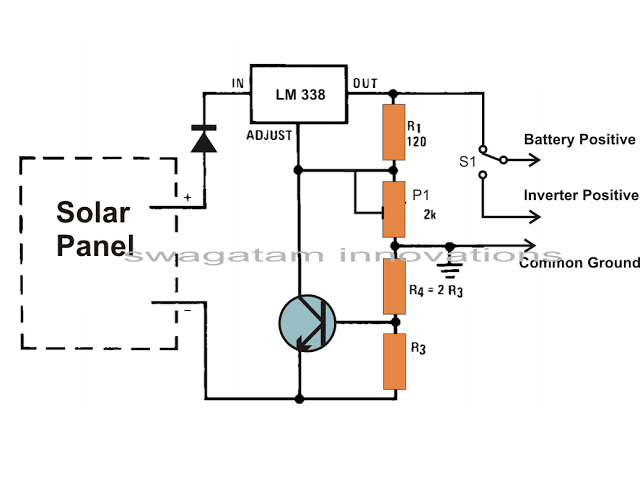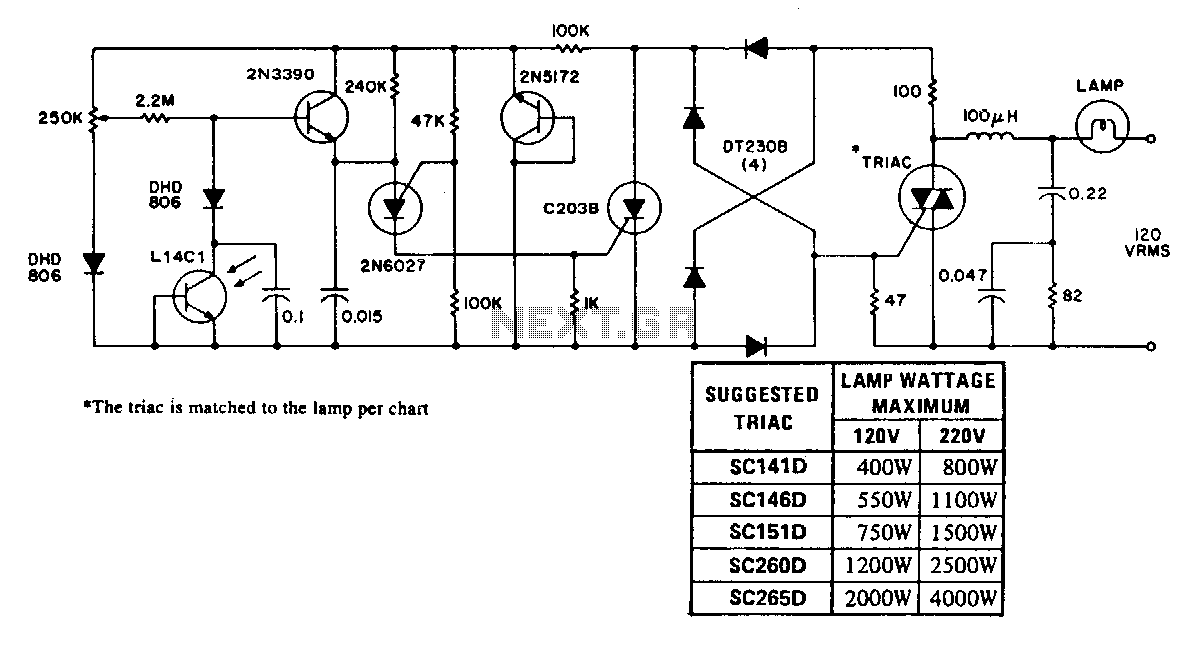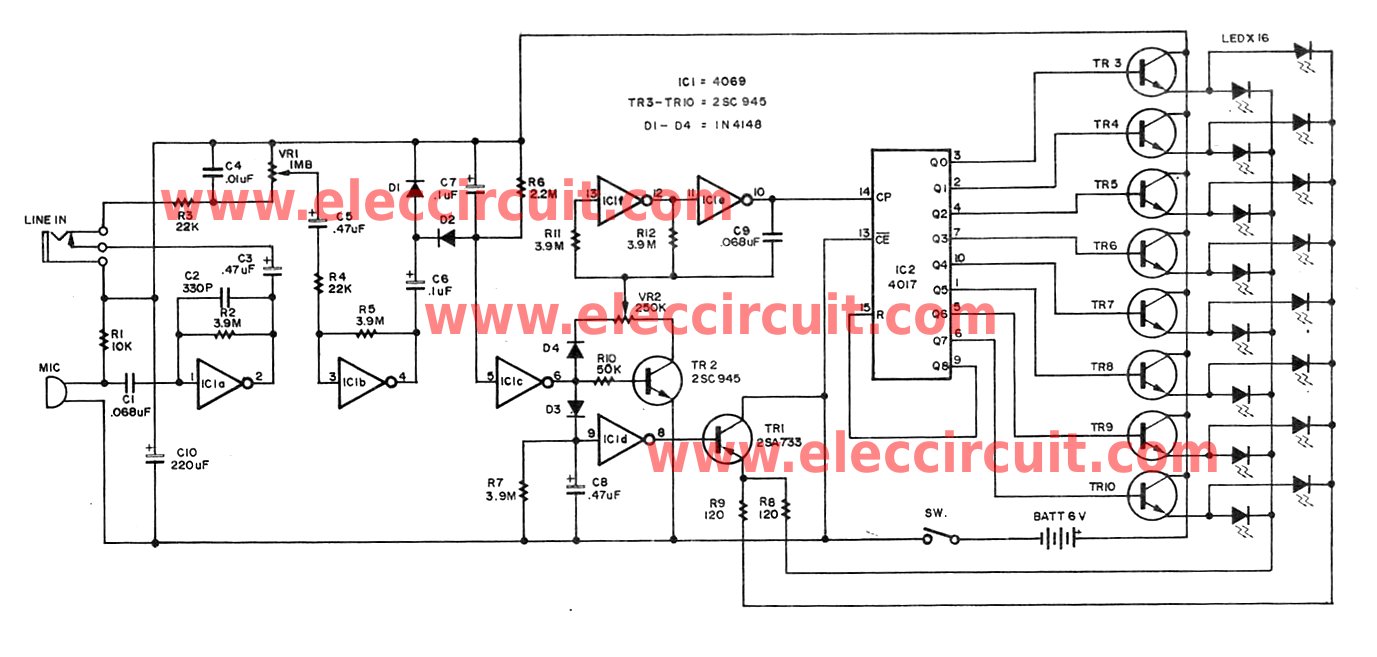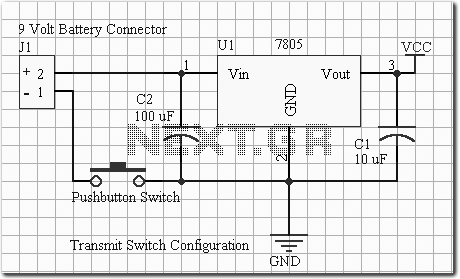
NiCad Charger with temp control
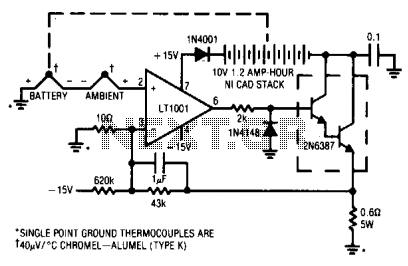
One effective method for rapidly charging Ni-Cad batteries without causing damage is to monitor the cell temperature and adjust the charge rate accordingly. This circuit employs a thermocouple for temperature measurement. A second thermocouple is used to negate the influence of ambient temperature. The voltage at the positive input of the amplifier is determined by the temperature difference between the two thermocouples. As the battery temperature increases, this small negative voltage (where a 1°C difference between the thermocouples corresponds to 40 mV) becomes more significant. The amplifier, which operates at a gain of 4300, progressively reduces the current supplied to the battery to keep its inputs balanced. The battery is charged at a high rate until it begins to heat up, at which point the circuit reduces the charge rate. The specified values in the circuit ensure that the rise in battery surface temperature above ambient remains around 5°C.
The described circuit is designed to optimize the charging process of nickel-cadmium (Ni-Cad) batteries by incorporating a feedback mechanism that utilizes thermocouples to monitor temperature changes. The first thermocouple is strategically placed to measure the temperature of the battery cells, while the second thermocouple is positioned to measure the ambient temperature, thus allowing for accurate compensation of environmental effects.
The voltage generated by the difference in temperature readings from the two thermocouples serves as an input to a high-gain amplifier, which is configured to amplify minor voltage changes. The amplifier's gain of 4300 ensures that even small temperature variations are effectively utilized to control the charging current. As the battery temperature rises due to charging, the voltage at the amplifier's positive input increases, leading to a corresponding adjustment in the output current.
This feedback control mechanism is crucial for preventing overheating of the battery. When the system detects an increase in temperature, the amplifier reduces the charging current, tapering the charge to maintain safe operating conditions. The design parameters are carefully selected to limit the increase in battery surface temperature to approximately 5°C above the ambient temperature, thereby enhancing battery longevity and safety during rapid charging operations.
The circuit may include additional components such as resistors for setting the gain, capacitors for stability, and possibly a microcontroller for more advanced monitoring and control features. Overall, the integration of temperature monitoring with adaptive charging current regulation represents a sophisticated approach to battery management, ensuring efficiency and safety during the charging process.One way to charge Ni-Cad batteries rapidly without abuse is to measure cell temperature and taper the charge accordingly. The circuit uses a thermocouple for this function. A second thermocouple nulls out the effects of ambient temperature. The temperature difference between the two thermocouples determines the voltage which appears at the amplifier's positive input.
As battery temperature rises, this small negative voltage (1°C difference between the thermocouples equals 40 ??) becomes larger. The amplifier, operating at a gain of 4300, gradually reduces the current through the battery to maintain its inputs at balance. The battery charges at a high rate until heating occurs and the circuit then tapers the charge. The values given in the circuit limit the battery surface temperature rise over ambient to about 5°C.
The described circuit is designed to optimize the charging process of nickel-cadmium (Ni-Cad) batteries by incorporating a feedback mechanism that utilizes thermocouples to monitor temperature changes. The first thermocouple is strategically placed to measure the temperature of the battery cells, while the second thermocouple is positioned to measure the ambient temperature, thus allowing for accurate compensation of environmental effects.
The voltage generated by the difference in temperature readings from the two thermocouples serves as an input to a high-gain amplifier, which is configured to amplify minor voltage changes. The amplifier's gain of 4300 ensures that even small temperature variations are effectively utilized to control the charging current. As the battery temperature rises due to charging, the voltage at the amplifier's positive input increases, leading to a corresponding adjustment in the output current.
This feedback control mechanism is crucial for preventing overheating of the battery. When the system detects an increase in temperature, the amplifier reduces the charging current, tapering the charge to maintain safe operating conditions. The design parameters are carefully selected to limit the increase in battery surface temperature to approximately 5°C above the ambient temperature, thereby enhancing battery longevity and safety during rapid charging operations.
The circuit may include additional components such as resistors for setting the gain, capacitors for stability, and possibly a microcontroller for more advanced monitoring and control features. Overall, the integration of temperature monitoring with adaptive charging current regulation represents a sophisticated approach to battery management, ensuring efficiency and safety during the charging process.One way to charge Ni-Cad batteries rapidly without abuse is to measure cell temperature and taper the charge accordingly. The circuit uses a thermocouple for this function. A second thermocouple nulls out the effects of ambient temperature. The temperature difference between the two thermocouples determines the voltage which appears at the amplifier's positive input.
As battery temperature rises, this small negative voltage (1°C difference between the thermocouples equals 40 ??) becomes larger. The amplifier, operating at a gain of 4300, gradually reduces the current through the battery to maintain its inputs at balance. The battery charges at a high rate until heating occurs and the circuit then tapers the charge. The values given in the circuit limit the battery surface temperature rise over ambient to about 5°C.
